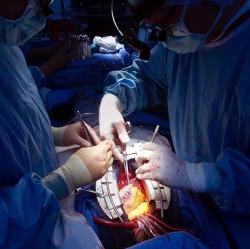
According to the US Centers for Disease Control and Prevention, about 5.8 million Americans suffer from heart failure and 670,000 new cases are diagnosed each year. One in five people with heart failure die within one year of diagnosis. Heart failure is most often treated with aggressive medical and device therapy, but has no cure. The most common symptoms of heart failure are shortness of breath, feeling tired, and swelling in the ankles, feet, legs, and sometimes the abdomen.
In this study presented at the ESC Congress 2012, researchers identified a new drug target that may treat and/or prevent heart failure. The team evaluated failing human and pig hearts and discovered that SUMO1 (small ubiquitin-like modifier), a small protein that regulates the activity of key transporter genes, was decreased in failing hearts. When the researchers injected SUMO1 into these hearts via gene therapy, cardiac function was significantly improved.
“This indicates that SUMO1 may play a critical role in the pathogenesis of heart failure,” said Professor Hajjar, who is research director of Mount Sinai’s Wiener Family Cardiovascular Research Laboratories.
Led by Professor Hajjar, the team has been evaluating the transporter gene SERCA2a in patients with severe heart failure as part of the CUPID (Calcium Up-regulation by Percutaneous administration of gene therapy In cardiac Disease) trial. When delivered via an adeno-associated virus vector—an inactive virus that acts as a medication transporter—into cardiac cells, SERCA2a demonstrated improvement or stabilisation with minimal side effects. But Professor Hajjar said: “We found that while injection with SERCA2a restored cardiac function, over time the new SERCA2a became dysfunctional. This indicated that something else upstream from SERCA2a was causing the dysfunction in the heart.”
Dr Changwon Kho, PhD, and Dr Ah Young Lee, PhD, two experts in the study of cardiac proteins at Mount Sinai School of Medicine, identified SUMO1 as the regulator of SERCA2a, showing that it enhanced its function and improved its stability and enzyme activity. When Professor Hajjar and his team studied human and animal models, they found that when SUMO1 was decreased, SERCA2a became dysfunctional in human hearts, showing that SUMO1 plays a protective role. When the team injected SUMO1 as a gene therapy, they found that it protected SERCA2a from oxidative stresses that are prevalent in heart failure.
